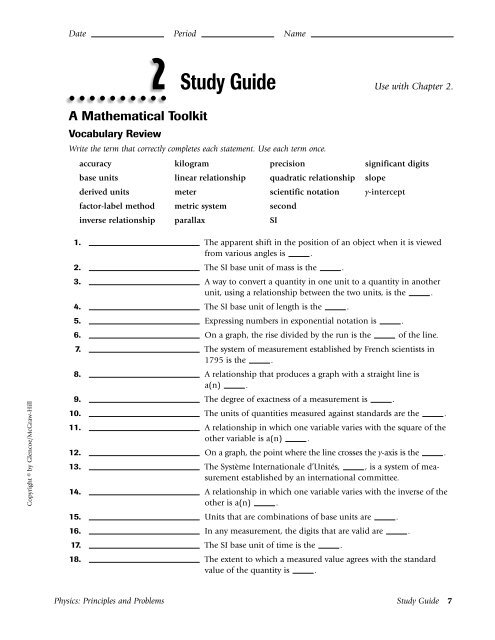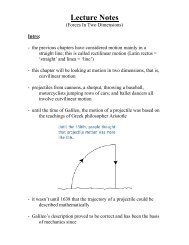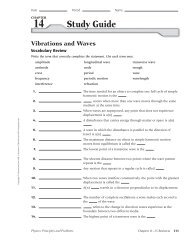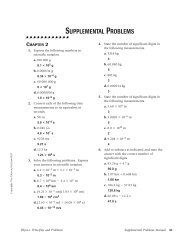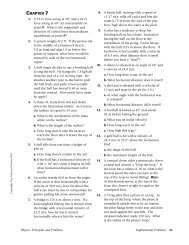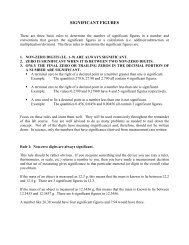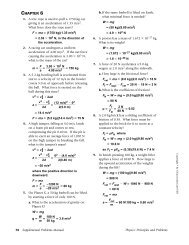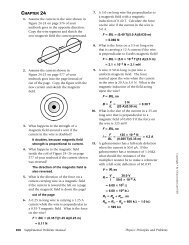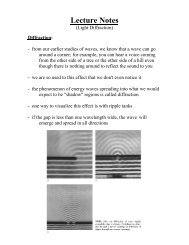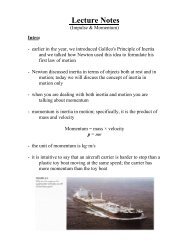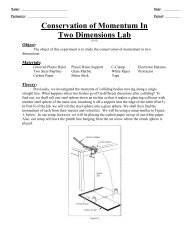Study Guide - Dickey Physics
Study Guide - Dickey Physics
Study Guide - Dickey Physics
- No tags were found...
Create successful ePaper yourself
Turn your PDF publications into a flip-book with our unique Google optimized e-Paper software.
2<strong>Study</strong> <strong>Guide</strong>NameSection 2.1: The Measures of ScienceIn your textbook, read about SI.For each base quantity on the left, write the matching base unit and the matching symbol.Base Unit Symbol1. length ampere cd2. mass candela kg3. time kelvin m4. temperature kilogram mol5. amount of a substance meter s6. electric current mole A7. luminous intensity second KAnswer the following questions, using complete sentences.8. What is the current definition of a meter?9. How is a second currently defined?10. What is the current definition of a kilogram?Copyright © by Glencoe/McGraw-Hill8 <strong>Study</strong> <strong>Guide</strong> <strong>Physics</strong>: Principles and Problems
2<strong>Study</strong> <strong>Guide</strong>NameIn your textbook, read about SI prefixes.Complete the table.Table 1Prefix Symbol Multiplier Scientific Notation11. 1/1 000 000 000 000 00012. pico13. 10 –914. micro15. 1/100016. 100017. mega18. 10 919. TWrite the term that correctly completes each statement.20. In scientific notation, the numerical part of a quantity is written as .Copyright © by Glencoe/McGraw-Hill21. In 10 n , n is an .22. In changing the numerical part of a measurement to scientific notation, the number of places youmove the decimal point to the left is expressed as aexponent.23. In changing the numerical part of a measurement to scientific notation, the number of places youmove the decimal point to the right is expressed as aexponent.<strong>Physics</strong>: Principles and Problems <strong>Study</strong> <strong>Guide</strong> 9
2<strong>Study</strong> <strong>Guide</strong>NameSection 2.2: Measurement UncertaintiesIn your textbook, read about accuracy and precision.Refer to the diagram below. Circle the letter of the choice that best completes each statement.22.922.822.722.7 ± 0.2°CStandard valueTemperature (°C)22.622.522.422.322.5 ± 0.1°C22.222.5 ± 0.2°C22.122.0A B CStudent22.4 ± 0.3°CD1. Measurements that have the same precision are those of students .a. A and B b. A and C c. A and D d. B and D2. Measurements that have the least precision are those of student .a. A b. B c. C d. D3. Measurements that have the greatest precision are those of student .a. A b. B c. C d. D4. Measurements that have the same accuracy are those of students .a. A and B b. A and C c. A and D d. B and D5. Measurements that have the least accuracy are those of student .a. A b. B c. C d. D6. Measurements that have the greatest accuracy are those of students .a. A and B b. A and C c. A and D d. B and D7. The most precise and accurate measurements are those of student .a. A b. B c. C d. D8. To assure the greatest precision and accuracy in reading an instrument such as a thermometer,you should read the instrument .a. below eye level b. above eye level c. at eye levelCopyright © by Glencoe/McGraw-Hill10 <strong>Study</strong> <strong>Guide</strong> <strong>Physics</strong>: Principles and Problems
Copyright © by Glencoe/McGraw-Hill2 <strong>Study</strong> <strong>Guide</strong>Name5013 m20. 1900 m/s2.6 sIn your textbook, read about significant digits.Write the letter of each rule that is used to determine the correct number of significant digits in eachmeasurement below. Then write the measurement in scientific notation.Measurement Rules Used Scientific Notation Rules9. 321 ma. Nonzero digits are always10. 1201 ssignificant.11. 1.0 m/sb. All final zeros after the decimalpoint are significant.12. 0.01 Kc. Zeros between two other13. 70.010 Mgsignificant digits are alwayssignificant.14. 53 000 000 cmd. Zeros used solely as placeholdersare not significant.15. 0.200 A16. 40 000 L17. 0.680 kgIn your textbook, read about arithmetic with significant digits.Explain how the number of significant digits was determined for the answer to each problem.18. 21.65 mm14.00 mm 1.2 mm37.9 mm19. 0.62 m 3.57 m2.2 m 2<strong>Physics</strong>: Principles and Problems <strong>Study</strong> <strong>Guide</strong> 11


